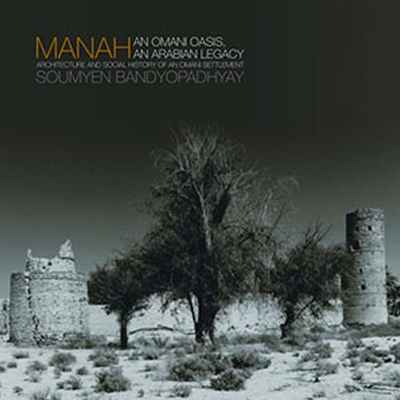Publications
Manah: Omani Oasis, Arabian Legacy
Bandyopadhyay, S., 2011. Manah: Omani Oasis, Arabian Legacy; architecture and social history of an Omani Oasis settlement. Liverpool: Liverpool University Press.
About the Book
The book is an attempt to understand the vernacular architecture of a corner of the Arabian Peninsula that has not received its due attention. Concerned primarily with meaning within the Omani vernacular built environment, the book makes no claims towards being a comprehensive documentation of Manah oasis and the architecture of its core settlement, Harat al-Bilad of Manah, which it nevertheless studies in some detail. Section I provides the historical and geographical context of the study. Section II, describes the oasis of Manah – its setting and structure, the settlement quarter of Harat al-Bilad and tribal mosaic in some detail. Section III contains the interpretive chapters; it begins with a study of settlement evolution and morphology, followed by extended discussion on the nature of the sacred: role of water and springs, the nature of the mosque and the decorated prayer niche. The book ends with a discussion on the key continuities and inventions evident within Omani vernacular architecture. By using viewpoints promulgated by Serjeant, Robertson Smith and Wheeler, the book argues that amidst several evidences of continuity, Omani sacred architecture exhibit crucial inventions and departures that clearly indicate the creative and interpretive intentions in Omani vernacular architecture.
Contents
Chapter 1: Passages to a land-locked island
This first chapter introduces the geographical area of our concern and discusses the peculiar physical isolation of central Oman and how it contributed towards a degree of socio-cultural and political seclusion. However, as the chapter argues, concealed behind such an apparent isolation there always flowed a perennial undercurrent of connections with other parts of Arabia and the Middle East.
Chapter 2: The core revealed
This chapter maps external interest in central Oman from the days of the early-Arab travellers until the advent of the Europeans travellers and researchers with serious interest in the land. It goes on to discuss the present state of knowledge of Omani architecture and the problems confronting the discipline of Oman Studies arising from a certain scientific ‘objectivity’ that precludes possibilities of interpretation.
Chapter 3: Settlement since time immemorial
This chapter discusses settlement evolution since pre-history until the early-Islamic times to illustrate the rich cultural palimpsest inherited by the present day oasis settlement of Manah.
Chapter 4: Fort, fortification and defensive strategies
This chapter describes the ruined fort Husn Manhia and the defensive features of the town. In discussing defensive strategies the chapter argues that the fort and the town had always had an uneasy coexistence.
Chapter 5: Townscape and urban structure
This chapter describes the urban qualities of Harat al-Bilad and analyses its structure in the light of material from other settlements of central Oman. It argues that its dense fabric is a result of an urban structure best suited for settlement on the edge of scarce arable land.
Chapter 6: The mosques of Harat al-Bilad
This chapter describes the mosques of Harat al-Bilad and its distinctive locational and formal characteristics.
Chapter 7: Water, purity and places of worship
This chapter examines the role of the spring and the wadi in defining sacredness and the location of places of worship by drawing on material from Islamic exegeses, pre-Islamic Arab cultures, extant popular Omani traditions and archaeological findings, in an attempt to chart the trajectory of their complex evolution.
Chapter 8: From the twilight of cultural memory, mosque form, bumah and mihrab
This chapter traces the origin of the distinctive cuboid form of the prayer hall back to the pre-Islamic temples of Hadramawt and upper Yemen. A deep-rooted pan-Semitic understanding of sacredness and sacrifice is also found to underscore the bumah, the name given to the peculiar cupola atop the prayer hall, originally devised for the call to prayers. The prayer niche, mihrab, on the other hand, contains decoration of Persian origin, perhaps displaying mystical influences within Ibadi asceticism.
Chapter 9: The tribal mosaic, communal structures and wells
This chapter maps the tribes and clans which once inhabited Harat al-Bilad and discusses their origin, political alliances and conflicts within the region. The major tribes had their own communal meeting halls or sablah-s, where daily gatherings took place following the ritual prayers. However, social stratification, so vehemently opposed by Islam, existed as a reminder of pre-Islamic Persian presence.
Chapter 10: Dwellings
This chapter catalogues a representative selection of dwellings belonging to the different tribes of Harat al-Bilad and establishes the key characteristics of central Omani dwellings.
Chapter 11: The deconstructed courtyard, veil and privacy
This chapter examines the spatial nature of the central Omani dwelling and argues that the assumed ubiquity of the courtyard at the core of Islamic dwelling typology does not apply to its central Omani counterpart. Instead, the function and role of the courtyard is disaggregated amongst a first floor terrace, a women’s julus (meeting room) and a small light shaft. The devices to achieve privacy within dwellings are also analysed.
Chapter 12: Epilogue
This chapter sums up the major findings and identifies areas of further research.

| Author(s) | Soumyen Bandyopadhyay |
| Country | United Kingdom |
| Language | English |
| Subject | Vernacular architecture |
| Area covered | Arabian peninsula |
| Publisher | Liverpool University Press |
| Publication date | 30 June 2011 |
| Type | Book |
| Pages | 352 |
| ISBN | 978-1846311215 |
